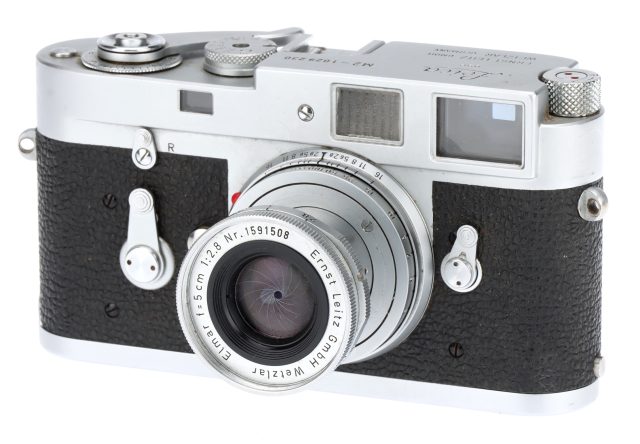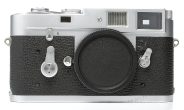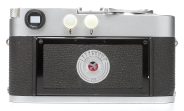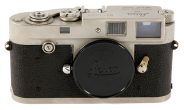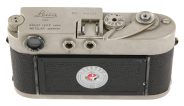Announced
Production status
Order No.
- KOOHE / 10300 - M2X without lens
- 10301 - M2X with SUMMICRON 35/2
- 10303 - M2X with SUMMARON 35/2.8
- KIHOO / 10357 - M2X with ELMAR 50/2.8
- KSOOB / 10367 - M2X with SUMMILUX 50/1.4
- KIOOL / 10380 - M2X with SUMMICRON 50/2
- KNOOG / 10385 - M2X with SUMMICRON 50/2 with near-focusing range
- KOOHW / 10308 - M2 without lens
- 10309 - M2 without lens, black
- 10331 - M2 with SUMMICRON 35/2
- 10333 - M2 with SUMMARON 35/2.8
- 10335 - M2 with ELMAR 50/2.8
- 10336 - M2 with SUMMICRON 50/2
- 10337 - M2 with SUMMILUX 50/1.4
- 10338 - M2 with SUMMICRON 50/2 with near-focusing range
- KEZOO / 10339 - M2 with ELMAR 50/3.5
System
Leica M system cameras
- Leica M (Typ 240)
- Leica M (Typ 262)
- Leica M Monochrom
- Leica M Monochrom (Typ 246)
- Leica M-A (Typ 127)
- Leica M-D (Typ 262)
- Leica M-E (Typ 220)
- Leica M-E (Typ 240)
- Leica M-P (Typ 240)
- Leica M1
- Leica M10
- Leica M10 Monochrom
- Leica M10-D
- Leica M10-P
- Leica M10-R
- Leica M11
- Leica M11 Monochrom
- Leica M11-P
- Leica M2
- Leica M3
- Leica M4
- Leica M4-2
- Leica M4-P
- Leica M5
- Leica M6
- Leica M6 (Typ 2248)
- Leica M6 Panda
- Leica M6 Titanium
- Leica M6 TTL
- Leica M6J
- Leica M7
- Leica M8
- Leica M8.2
- Leica M9
- Leica M9-P
- Leica MD
- Leica MD-2
- Leica MDa
- Leica MP
- Leica MP Original
Leica M2
35mm MF film rangefinder camera • Discontinued
Specification
| Format: | |
| 35mm full frame | |
Film type: | 135 cartridge-loaded film |
| Leica M [27.8mm] | |
| Shutter: | |
Type: | Focal-plane |
Model: | Mechanical |
Speeds: | 1 - 1/1000 + B |
| Exposure: | |
Exposure metering: | None |
Exposure modes: | Manual |
| Rangefinder and Viewfinder: | |
Rangefinder: | Built-in, combined with viewfinder |
Viewfinder: | Built-in, combined with rangefinder |
Finder magnification: | 0.72x |
Actual rangefinder base: | 68.5mm |
Effective rangefinder base: | 49.32mm |
Bright-line frames: | 35mm, 50mm, 90mm |
Parallax compensation: | Yes |
| Physical characteristics: | |
Weight: | 580g |
Dimensions: | 138x77x33.5mm |
| Accessories: | |
Body cap: | IVZOO / 14056 |
Manufacturer description #1
From the LEICA photography magazine (1958, No. 3):
big news
On our back cover, you will see news of a Leica so new that there was no time to describe it inside this issue. But by the time you read this, your dealer will have the M-2 in stock.
Late in September, Photokina, the famous European exposition, will open. There, the Leitz factory will show other new, exciting equipment for the Leica System of photography.
announcing the great new LEICA M-2
gives you the many famous Leica features plus built-in wide angle viewing
at an irresistibly low price
features of the new Leica M-2
- built-in luminous frame for the wide-angle 35mm lens
- 50mm frame and 90mm frame which appear automatically as lenses are inserted
- single-window viewfinder-rangefinder
- automatic parallax correction throughout
- frame selector
- accepts bayonet-mount Leica lenses
- fast-action advance lever
- automatic flash synchronization
- one shutter dial - 1/1000 second to 1 second and "Bulb"
- release button for rewind
- Leica-meter "MC" couples to M-2 (optional)
Manufacturer description #2
The Leica M 2 is a companion camera to the M 3, with features designed for photographers whose needs vary somewhat from those of M 3 users. The single-window, combination range- and viewfinder system of the Leica M 2 has built-in bright-line frames for 35mm wide-angle, 50mm standard, and 90mm long-focus lenses.
Parallax compensation is automatic throughout the focusing range of all three lenses, and a frame selector similar to that of the M 3 permits pre-selection of the proper lens for the job. Unique indicator "tabs" on the top and bottom of the M 2 rangefinder field are used to check quickly which subject areas are within the depth of field of the most-used lenses at specific apertures. The top "tab" checks 50mm field depth at f/16, and 35mm field depth at f/5.6. The bottom "tab" is for 50mm lenses at f/5.6 and is well within the depth of field limits of 35mm lenses at f/3.5. The M 2 like the M 3, has automatic synchronization for all types of fIash. Shutter speeds are from 1 second to 1/1000 second and "Bulb". The M 2 accepts all bayonet-mount Leica lenses and M 3 accessories except earlier bayonet-mounted 35mm wide-angle lenses.
A "universal" rapid advance lever permits the M 2 user to advance film and wind the shutter with as few or as many strokes as he pleases - one, two, or more.
The Leica M 2 will accept a new model of the Leicavit Rapid winder (when available) for those who prefer baseplate winding and film advance. Film rewinding is controlled by depressing a button, which returns to the "advance" position automatically when released. The M 2's exposure counter is set by hand at the start of each roll of film.
Manufacturer description #3
As LEICA M 3, with the following differences: Automatically superimposed image frames for 35, 50 and 90 mm focal lengths. Film counter must be returned to 0 by hand. From 1959 with self-timer. Serial No. from 926001.
Manufacturer description #4
The LEICA M 2 captures every photographic situation swiftly and surely. Its unsurpassed range- viewfinder enables even the beginner to focus easily, rapidly, and with unerring accuracy, regardless of the existing lighting conditions. The brilliantly illuminated focal frames for the 35-, 50- and 90 mm lenses are automatically parallax-compensated at all focusing distances. Inserting anyone of these three prime picture-makers into the LEICA M 2's quick-change bayonet lens-mount automatically brings the correct frame into the viewfinder, and a preselector lever is provided so that the user can determine the effect of these three focal lengths without actually changing lenses. Accurate exposure setting is ensured by the accessory LEICAMETER MC which couples to the camera's non-spinning shutter-speed selector dial.
Sturdily constructed and easy to use, the LEICA M 2 combines traditional LEITZ precision, ruggedness and reliability with almost unbelievable versatility. The VISOFLEX II, a key part of the LEICA SYSTEM offers the additional possibility of reflex groundglass focusing and viewing with focal lengths from 65- through 400 mm, and a number of LEICA lenses may actually be used with both rangefinder and reflex focusing.
From its pioneering beginning the LEICA has logically pursued and perfected three important design attributes:
1. The Direct-Vision Optical Viewfinder
The optical finder system, developed to its present high level in the LEICA M2, permits the photographer to concentrate completely upon his picture up to and through the decisive moment of exposure. The built-in focal frames for the 35-, 50- and 90 mm lenses permit simultaneous focusing and framing without changing the eye position, and these frames are automatically parallax compensated over the full focusing range to eliminate the possibility of accidentally chopped-off heads or feet.
2. The Precision Focal-Plane Shutter
The LEICA's superbly accurate focal-plane shutter permits the use of all interchangeable lens focal lengths and lens apertures without any loss of efficiency, thus providing the fundamental basis for the extremely versatile LEICA SYSTEM. It is speeded from 1 to 1/1000 sec, plus Bulb, and is provided with a delayed action self-timer plus full flash synchronization. Its rugged reliability and extreme quietness are the result of its excellent design and the tradition of LEITZ precision that goes into its careful construction.
3. Interchangeable Lenses of the Highest Quality
The exceptional image quality of interchangeable LEICA lenses is proverbial. This outstanding performance is based upon over a century of scientific optical experience combined with the most modern design and production methods which include the development of special rare-earth optical glasses in LEITZ' own research laboratories. LEICA quality control requires a testing procedure which begins with the raw glass and continues throughout the production stages until film resolving-power tests are made with each lens before shipment.
LEICA M 2 specifications
All-metal die-cast body with strap eyelets, black-grained rubberoid covering and chromium-plated metal parts. Brilliant-frame long-base range-view-finder with parallax compensated built-in frames appearing automatically when 35-, 50- or 90 mm lenses are inserted into the quick-change bayonet lens mount. Accepts lenses from 21- to 135 mm with rangefinder focusing, 65- to 400mm with VISOFLEX II reflex groundglass focusing. Focal-plane shutter speeded from 1 to 1/1000 sec. plus Bulb, with non-spinning speed selector dial coupling to LEICAMETER MC. Synchronization for flash bulbs at all speeds; for electronic-flash at 1/50th sec. Delayed-action self timer. Single-stroke rapid-advance lever for rapid film transport coupled to shutter re-set mechanism and frame-counter. Hinged flip-open back for easy film loading. Removeable baseplate interchangeable with LEICAVIT rapid-sequence device. Standard accesory shoe. (Note: LEICA cameras are usually supplied with 1/4" English tripod sockets; on special order they may also be obtained with the 3/8" Continental bushing.)
Manufacturer description #5
From the LEICA photography magazine (1958, No. 4):
Ever since the Model A was introduced in 1924, the professional photographer and the Leica have exerted a very profound influence upon each other's development. The most recent evidence of this interaction is the brand-new M 2 Leica, a pro's camera from baseplate to accessory shoe. To understand the thinking behind the M 2, it is first necessary to know a few things about the photographers whose working methods played the decisive role in its design.
The professional photojournalist has been defined as a man with seven cameras and a working wife, but this probably involves an element of exaggeration. The average professional Leicaman almost always works with a minimum of two camera bodies, and the joint use of three is far from uncommon. His basic optical outfit consists of three focal lengths: the 35mm wide-angle, the 50mm normal focus, and the 90mm long-focus lenses.
the handy wide-angle
The 35 is particularly handy under cramped conditions when it's necessary to relate subjects to their surroundings. For tightly cropped pictures, when the requirement is to isolate subjects and to simplify picture content, there's nothing like a 90. Between these include-more and crop-tight assignments, the 50 is the Leicaman's most versatile weapon. The pro, of course, also employs a wide variety of additional focal lengths, but these are specialists. On most of his assignments, most of his pictures are the work of the basic 35-50-90 team.
At Photokina 1954, professionals found most of their needs met by a completely new sort of Leica, the M 3. Overnight the M 3 became a professional mainstay, and more pros today use this camera than any other currently produced high-grade miniature.
M 3 and M 2 compared
Let us now run through the principal features which account for the M 3's tremendous professional acceptance, comparing each in turn with the new M 2.
(1) The first reason for the M 3's acclaim probably was its brilliant rangefinder (combined with its viewfinder system through a single eyepiece). This makes accurate focus not merely possible, but amazingly easy - under even the worst "available-darkness" conditions. This outstanding rangefinder has been continued in the M 2, with the addition of two depth-of-field check tabs, for f/5.6 and f/16.
(2) Next comes the unique M 3 viewfinder system in which specially illuminated focal frames for the 50, 90, and 135mm lenses appear automatically as soon as the appropriate bayonet-mounted Leica lens is locked into the M 3's rugged quick-switch lens mount. Later, this 50-90-135 bright-field framing was extended to the 35mm focal length via the "RF" Summaron which positions special optical "minifying" elements over the M 3's range- and viewfinder windows to convert its 50mm frame lines to the 35mm wide-angle field of view.
35-50-90 emerges
The M 3 was a great step forward. But a lot of photographers rarely, if ever, needed the 135mm frame. They preferred a built-in 35mm frame that would not require the Optical Viewing Unit of the "RF" Summaron. The M 2 gives it to them. Changing the viewfinder's image size to .75X (compared to the M 3's .90X) permitted a 35-50-90mm frame combination. At this image ratio, a 135mm frame would be impractically small for accurate work. But wide-anglers lose little by its absence.
(3) Third on our list of features which make the M 3 popular is automatic and continuous parallax correction. Its mechanism, through a linkage with the rangefinder, causes the M 3's focal frames to slide diagonally within the image field to eliminate framing errors at all focusing distances. (The Dual-Range Summicron's Optical Viewing Unit extends automatic parallax correction down to 19 inches!)
a first for the M 2
The same automatic parallax correction is incorporated into the M 2, accomodating, for the first time in any interchangeable lens camera (except for the M 3 with "RF" Summaron), the 35mm focal frame in addition to the 50mm and 90mm frames.
(4) Another standout M 3 feature is its surprisingly quiet focal-plane shutter which provides all speeds from 1 to 1/1000 second. The M 2 has the same shutter and the same speed selector dial. The dial does not rotate as film is advanced. This means speed can be changed before or after advancing film. The dial is slotted to accept the Leica-Meters "M," and "MC" - another big M 3 plus which has been extended into the M 2 design. Automatic flash synchronization for both conventional and electronic flash is built into both the M 3 and M 2.
unique advance lever
(5) The extremely smooth operating M 3 advance lever was a great source of M 3 enthusiasm. It operates with so little camera jar that you can actually maintain subject framing, and even refocus while operating the advance mechanism. In the M 2, the advance lever operates either with one long (about 110 degrees) or with two or more shorter strokes, and the camera has been constructed to accept both Leicavit and motor-drive baseplate accessories. The M 2 Leicavit is not yet available but should be by some time in 1959; the electric motor drive unit for sequence photography will take a bit longer.
(6) Last of the M 3 features is the flip-open back which facilitates quicker loading, swings out to expose the film gate and pressure plate for occasionally-needed cleanings. Built into the back is a film reminder dial. The flip-open back is an exclusive of the M-cameras and is an integral part of the M 2 body design.
economy in the M 2
To most pros, and many active amateurs, a Leica outfit means a minimum of two and often three bodies. So, to keep costs down on the new M 2 without giving up any essential features of the M 3 or relaxing perfectionist standards of workmanship, Leitz had just one path open: eliminate in the M 2 every M 3 feature that wasn't absolutely essential. Analysis revealed only three features that the designers would consider scrapping - these are:
(1) The automatically resetting frame counter. In-stead of this the M 2 has a manually-set counter that is concentric with the M 2 release button.
(2) The built-in self-timer. The M 2 has none.
(3) The advance/rewind lever of the M 3 has been changed in the M 2 to a simple push-button device.
Another item appears on the M 2 as a sort of bonus feature. Although not absolutely essential, the focal pre-selector switch on the M 3 is a great convenience to many. It is carried over to the M 2 for previewing of the subject through the frames for the 35mm, 50mm, and 90mm frames.
From the editor
A less expensive alternative to the M3. It has most of the features of that model. It does, however, differ in some minor respects:
- Built-in, bright-line frames for 35mm, 50mm and 90mm lenses.
- Viewfinder magnification reduced to 0.72x (to accomodate 35mm frame);
- Depth of field indicator in viewfinder;
- Manually-reset automatic exposure counter;
- May be used with a Leicavit Rapid Winder base-plate without modification (The Leicavit cannot be used on the M3);
- Self-timer built-in from No. 1,004,151 but absent in a variation of the M2 called M2X.
Silver chrome finish, but a small number of bodies were in black.
Special editions (1)
- Leica M2R - 1969
Similar cameras (13)
35mm full frame • Manual focus • Film • Rangefinder • Leica M mount
| Model | Shutter | Metering | Modes | Year |
|---|---|---|---|---|
| Cosina Voigtlander BESSA-R2 | M, 1/2000 | TTL • WA | M | 2002 ● |
| Cosina Voigtlander BESSA-R2A | E, 1/2000 | TTL • WA | AM | 2004 ● |
| Cosina Voigtlander BESSA-R2M | M, 1/2000 | TTL • WA | M | 2006 ● |
| Cosina Voigtlander BESSA-R3A | E, 1/2000 | TTL • WA | AM | 2004 ● |
| Cosina Voigtlander BESSA-R3M | M, 1/2000 | TTL • WA | M | 2006 ● |
| Cosina Voigtlander BESSA-R4A | E, 1/2000 | TTL • WA | AM | 2006 ● |
| Cosina Voigtlander BESSA-R4M | M, 1/2000 | TTL • WA | M | 2006 ● |
| Cosina Voigtlander BESSA-T | M, 1/2000 | TTL • WA | M | 2001 ● |
| Konica HEXAR RF | E, 1/4000 | TTL • WA | AM | 1999 ● |
| Leica CL aka LEITZ minolta CL |
M, 1/1000 | TTL • WA | M | 1973 ● |
| Minolta CLE | E, 1/1000 | TTL • WA | AM | 1980 ● |
| Rollei 35 RF | M, 1/2000 | TTL • WA | M | 2002 ● |
| Zeiss Ikon | E, 1/2000 | TTL • WA | AM | 2004 ● |
